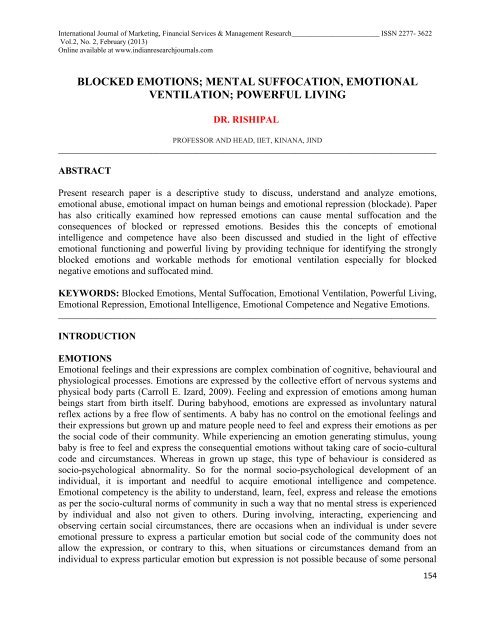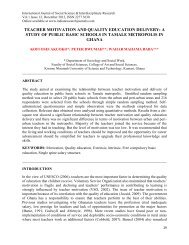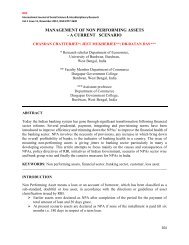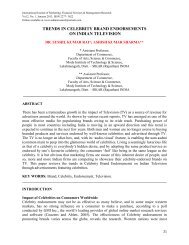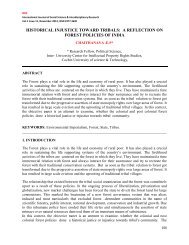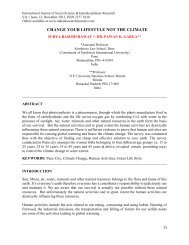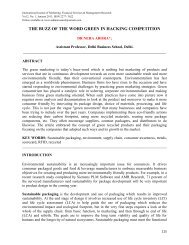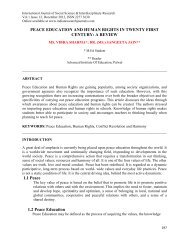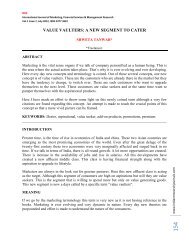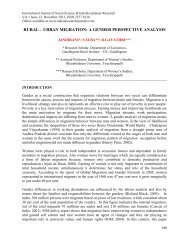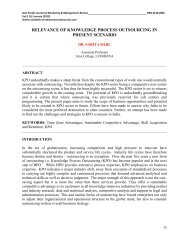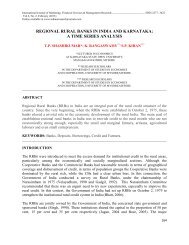blocked emotions - Indianresearchjournals.com
blocked emotions - Indianresearchjournals.com
blocked emotions - Indianresearchjournals.com
Create successful ePaper yourself
Turn your PDF publications into a flip-book with our unique Google optimized e-Paper software.
International Journal of Marketing, Financial Services & Management Research________________________ ISSN 2277- 3622<br />
Vol.2, No. 2, February (2013)<br />
Online available at www.indianresearchjournals.<strong>com</strong><br />
BLOCKED EMOTIONS; MENTAL SUFFOCATION, EMOTIONAL<br />
VENTILATION; POWERFUL LIVING<br />
DR. RISHIPAL<br />
PROFESSOR AND HEAD, IIET, KINANA, JIND<br />
_____________________________________________________________________________________<br />
ABSTRACT<br />
Present research paper is a descriptive study to discuss, understand and analyze <strong>emotions</strong>,<br />
emotional abuse, emotional impact on human beings and emotional repression (blockade). Paper<br />
has also critically examined how repressed <strong>emotions</strong> can cause mental suffocation and the<br />
consequences of <strong>blocked</strong> or repressed <strong>emotions</strong>. Besides this the concepts of emotional<br />
intelligence and <strong>com</strong>petence have also been discussed and studied in the light of effective<br />
emotional functioning and powerful living by providing technique for identifying the strongly<br />
<strong>blocked</strong> <strong>emotions</strong> and workable methods for emotional ventilation especially for <strong>blocked</strong><br />
negative <strong>emotions</strong> and suffocated mind.<br />
KEYWORDS: Blocked Emotions, Mental Suffocation, Emotional Ventilation, Powerful Living,<br />
Emotional Repression, Emotional Intelligence, Emotional Competence and Negative Emotions.<br />
_____________________________________________________________________________________<br />
INTRODUCTION<br />
EMOTIONS<br />
Emotional feelings and their expressions are <strong>com</strong>plex <strong>com</strong>bination of cognitive, behavioural and<br />
physiological processes. Emotions are expressed by the collective effort of nervous systems and<br />
physical body parts (Carroll E. Izard, 2009). Feeling and expression of <strong>emotions</strong> among human<br />
beings start from birth itself. During babyhood, <strong>emotions</strong> are expressed as involuntary natural<br />
reflex actions by a free flow of sentiments. A baby has no control on the emotional feelings and<br />
their expressions but grown up and mature people need to feel and express their <strong>emotions</strong> as per<br />
the social code of their <strong>com</strong>munity. While experiencing an emotion generating stimulus, young<br />
baby is free to feel and express the consequential <strong>emotions</strong> without taking care of socio-cultural<br />
code and circumstances. Whereas in grown up stage, this type of behaviour is considered as<br />
socio-psychological abnormality. So for the normal socio-psychological development of an<br />
individual, it is important and needful to acquire emotional intelligence and <strong>com</strong>petence.<br />
Emotional <strong>com</strong>petency is the ability to understand, learn, feel, express and release the <strong>emotions</strong><br />
as per the socio-cultural norms of <strong>com</strong>munity in such a way that no mental stress is experienced<br />
by individual and also not given to others. During involving, interacting, experiencing and<br />
observing certain social circumstances, there are occasions when an individual is under severe<br />
emotional pressure to express a particular emotion but social code of the <strong>com</strong>munity does not<br />
allow the expression, or contrary to this, when situations or circumstances demand from an<br />
individual to express particular emotion but expression is not possible because of some personal<br />
154
International Journal of Marketing, Financial Services & Management Research________________________ ISSN 2277- 3622<br />
Vol.2, No. 2, February (2013)<br />
Online available at www.indianresearchjournals.<strong>com</strong><br />
or other reasons. Such kind of experience creates emotional and mental pressure. Persistent and<br />
repeated pressure on human psyche can struck an individual to the state of emotional <strong>blocked</strong><br />
and mental suffocation. Non-ventilation of emotional <strong>blocked</strong> or mental suffocation is the basic<br />
cause for mental stress and tension. A prolonged and continuous mental tension is cause of<br />
certain mental and physical disorders. Present paper will discuss about, how <strong>blocked</strong> <strong>emotions</strong><br />
can create mental suffocation and their effective ventilation can lead to powerful living.<br />
IMPACT OF EMOTIONS ON HUMAN BEING<br />
Emotions control and regulate individual‟s thinking, behavior and actions. Emotions affect<br />
physical bodies in a similar way as body affects feelings and thinking. People, who ignore,<br />
condemn, repress or do not express and ventilate their <strong>emotions</strong> properly, set themselves for<br />
psychological and physical disorders. Emotions that are not felt and released but buried within<br />
the human psyche and body can cause serious disorder like cancer, arthritis, and many types of<br />
chronic illnesses. Negative <strong>emotions</strong> such as fear, anxiety, negativity, frustration and depression<br />
cause chemical reactions in body that are very different from the chemicals released when a<br />
person is experiencing and feeling positive <strong>emotions</strong> such as happiness, contentment, love and<br />
acceptance. Emotions have a direct effect on the working of body. Negative <strong>emotions</strong> stimulate<br />
the human glandular system for the release of harmful chemicals (hormones) while positive<br />
<strong>emotions</strong> release useful chemicals in the form of hormones. If negative <strong>emotions</strong> persist in the<br />
psyche of individual for a long-term or chronic, they can affect the chemical balance and other<br />
body systems such as the immune, endocrine systems.<br />
Individual cannot check, control or stop the feeling of <strong>emotions</strong> but can learn how to manage,<br />
adjust and live with them. If someone tries to control or repress the <strong>emotions</strong> they will not be<br />
repressed for a long time rather start leaking out. As much as someone tries to control and<br />
repress the <strong>emotions</strong> more pressure will generate for the release of <strong>emotions</strong>, it is a vicious circle.<br />
Expression of strong <strong>emotions</strong> in public place in modern world is considered as a weakness.<br />
People feel un<strong>com</strong>fortable with those who express strong <strong>emotions</strong>. Present day man is part of<br />
such a society that taught not to express strong <strong>emotions</strong> but to control and hide <strong>emotions</strong>. Free<br />
and uncontrolled expression of <strong>emotions</strong> gives a feeling to be ashamed of or to be afraid of,<br />
regardless, man is born with feeling and expression of <strong>emotions</strong> and he has to live with them<br />
having no control so it is necessary to acquire <strong>com</strong>petency know how to live with them, and<br />
release them.<br />
EMOTIONAL ABUSE<br />
Emotional abuse is a typical behaviour used by an individual or group, called emotional abuser,<br />
to dominate, exploit and encroach the rights of other person or group, called emotionally abused,<br />
by using the strong <strong>emotions</strong> and not giving chance or opportunity to the later to act and express<br />
freely. Emotional abuse is just as serious and harmful as physical abuse but is often ignored or<br />
minimized because physical violence is absent. Emotional abuse may include any or all of the<br />
following type of behaviours:<br />
Rejection<br />
Degrading<br />
Ridiculing<br />
Humiliating<br />
Insulting<br />
Terrorizing<br />
Isolating<br />
Exploiting<br />
Denying<br />
Silent treatment<br />
155
International Journal of Marketing, Financial Services & Management Research________________________ ISSN 2277- 3622<br />
Vol.2, No. 2, February (2013)<br />
Online available at www.indianresearchjournals.<strong>com</strong><br />
Emotions stemming from emotional abuse are deep and <strong>com</strong>plex, requiring ongoing help from<br />
those trained to deal with emotional abuse.<br />
EMOTIONAL REPRESSION AND BLOCKADE<br />
When an individual experiences a stressful, painful or difficult emotion there will be tendency to<br />
suppress, ignore, avoid or dismiss such emotion and easy way to do this is, either get busy or<br />
pretend that nothing has happened. In this type of situation person does not feel and express the<br />
emotion properly and it results in emotional <strong>blocked</strong>. These unexpressed feelings hang about in<br />
our nervous, muscular, glandular, digestive systems and/or other vital body organs as buried<br />
<strong>emotions</strong>. These <strong>emotions</strong> remain buried in body organs and systems until individual brings<br />
those <strong>emotions</strong> out (release out) by feeling, expressing and ventilating them. Emotions that are<br />
buried continuously and persistently for a prolonged time can cause psychosomatic, biological,<br />
pathological and physical disorders. Following are some of the methods which can be used to<br />
avoid feeling of their <strong>emotions</strong>.<br />
Ignoring the feelings<br />
Pretending something hasn‟t happened<br />
Overeating<br />
High sugar and fat diet consumption<br />
Drinking alcohol and use of drugs<br />
Adopting <strong>com</strong>pulsive behavior<br />
Excessive sex<br />
Keeping physically and mentally busy<br />
Watching TV and internet accessing<br />
Over working<br />
Non-participation in <strong>com</strong>munication<br />
Over projection of any one of the <strong>emotions</strong><br />
False expression of <strong>emotions</strong><br />
156
International Journal of Marketing, Financial Services & Management Research________________________ ISSN 2277- 3622<br />
Vol.2, No. 2, February (2013)<br />
Online available at www.indianresearchjournals.<strong>com</strong><br />
Expression of <strong>emotions</strong> is healthy and healing. Emotions that are bottled up for too long create<br />
mental suffocation and emotional blockade. For example, it is natural to feel grief and tears at the<br />
loss of a loved one. This emotion of grief will be <strong>blocked</strong>, if it is not felt properly and not<br />
allowed enough expression. This emotion of grief will likely to remain deep inside in the human<br />
psyche and consequently individual experiences an ongoing sadness, depression, numbness,<br />
irritation, anxiety, pressure and fear of unknown, which may be rooted in an experience, person<br />
had in the past. There may be sudden unexplained release of tears at unexpected times, or<br />
perhaps person is no longer able to weep at all, even when feeling to do so. Person may be<strong>com</strong>e<br />
intolerant of others and burst out unexpectedly on those who care a lot. All this is because,<br />
unexpressed <strong>emotions</strong> can generate emotional blockade and can drastically affect human<br />
behaviour, both negatively and positively (). Emotional blockade is a condition exhibiting one or<br />
more of the following characteristics over a long period of time and to a marked degree that<br />
adversely affects the behaviour and performance of individual.<br />
Inability to build or maintain satisfactory interpersonal relationships.<br />
Inability to act or react that cannot be explained by intellectual, sensory, or health factors.<br />
Inappropriate types of behaviour or feelings under normal circumstances.<br />
A general pervasive mood of unhappiness or depression.<br />
A tendency to develop physical symptoms for psychosomatic disorders or fears<br />
associated with personal problems.<br />
Hyperactivity (short attention span, impulsiveness).<br />
Aggression/self-injurious behavior (acting out, fighting).<br />
Withdrawal (failure to initiate interaction with others; retreat from exchanges of social<br />
interaction, excessive fear or anxiety).<br />
Immaturity (inappropriate crying, temper tantrums, poor coping skills).<br />
Learning difficulties (academically performing below grade level).<br />
The causes of emotional blockade have not been adequately determined. Although various<br />
factors such as heredity, brain disorder, diet, stress and family functioning have been suggested<br />
as possible causes, research has not shown any of these factors to be the direct cause of behavior<br />
or emotional problems.<br />
REPRESSED EMOTIONS CAUSES MENTAL SUFFOCATION<br />
Repression and burial of <strong>emotions</strong> consumes lot of mental and physical energy and creates<br />
mental suffocation. Prolonged burial of <strong>emotions</strong> lowers the overall tempo and suffocates mind<br />
and ultimately lead to illness and speed up ageing process. Blocked <strong>emotions</strong> create mental<br />
suffocation, uneasiness, tiredness, fatigue, loss of energy and depression (Karen Lawson 2009).<br />
Following are some major symptoms of buried and repressed <strong>emotions</strong>.<br />
Low energy level and fatigue<br />
Stress and depression<br />
Not interested to talk about personal matters and feelings<br />
Showing that some specific issue has no significance, whereas from within it matters<br />
Rarely talking about ones feelings<br />
Blowing up over minor incidents<br />
Gut feeling in stomach and tightness in throat<br />
157
International Journal of Marketing, Financial Services & Management Research________________________ ISSN 2277- 3622<br />
Vol.2, No. 2, February (2013)<br />
Online available at www.indianresearchjournals.<strong>com</strong><br />
<br />
<br />
<br />
<br />
<br />
Expression of anger not at the time of incident happened and on the person with whom<br />
emotional issue occurred but on somebody else at a later stage.<br />
Troubled personal relationships<br />
Lethargic in working<br />
Problem in acceptance of self and others<br />
Wearing the mask of smile and crying from inside<br />
CONSEQUENCES OF BLOCKED OR REPRESSED EMOTIONS<br />
Blocked or repressed <strong>emotions</strong> can cause major difficulties in the physical, mental, biological,<br />
psychological, Interpersonal and sociological interactions and functions of a human being.<br />
Blocked <strong>emotions</strong> can affect the relationships and abilities to grow and develop negativities<br />
(Johnson S. 2010). Continuous, persistent and prolonged emotional repression can cause serious<br />
mental and physical problems, like cancer, arthritis, chronic fatigue, digestive disorders, bowel<br />
problems and neuro-psychic problems. Since repressed <strong>emotions</strong> can rest in human psyche for a<br />
long time so, they can create energy loosing holes in the psychic system of an individual.<br />
Through these holes psychic energy leaks out to develop fatigue, a sense of vulnerability, and<br />
low self-confidence. A repressed emotion can control individual‟s behavior and reactions of past,<br />
present and future events. Individual buries <strong>emotions</strong> to protect them from embarrassing, pain<br />
and difficult to manage situations at the time of their occurrence. Lot of energy is required to<br />
bury and to keep the unpleasent <strong>emotions</strong> <strong>blocked</strong>. A continuous and multistage burial of<br />
<strong>emotions</strong> develop a state where there isn‟t much energy left with the individual for other<br />
activities. In such a case, energy is being used to keep stuffing these <strong>emotions</strong> back down to the<br />
unconscious human psyche. Once <strong>emotions</strong> are <strong>blocked</strong> in the human psyche they use to keep on<br />
popping up frequently upto when they are not released knowingly and unknowingly. Individual<br />
has to work very hard to keep the <strong>blocked</strong> <strong>emotions</strong> stuffed down in the human psyche.<br />
EMOTIONAL INTELLIGENCE AND COMPETENCE<br />
Emotional Intelligence may be described as ability of an individual to perceive, analyze and<br />
manage the <strong>emotions</strong> for effective adjustment and adaptation according to the need of social<br />
code of behavior of the <strong>com</strong>munity to which individual belongs. In 1980 Reuven Bar-on<br />
developed the concept of Emotional Intelligence. Understanding and Learning of cause and<br />
effect relationship of emotional feeling, expression and timely releasing is called Emotional<br />
Intelligence (EI). Development and understanding of emotional intelligence is necessary to<br />
identify, distinguish and manage one‟s own and others‟ <strong>emotions</strong> for effectual interpersonal<br />
relationships and adjustment. Emotional intelligence always leads to emotional <strong>com</strong>petence.<br />
Emotional intelligence determines one‟s potential for learning the behavioural skills of using<br />
<strong>emotions</strong> and emotional <strong>com</strong>petence. Emotional Competence refers to a person‟s expertise in<br />
expressing or releasing their <strong>emotions</strong>. The concept of emotional <strong>com</strong>petence is rooted in the<br />
understanding of <strong>emotions</strong> as being normal, useful aspects of being human. Anger is a resultant<br />
of aggression and equips a person with the strength to repel the aggression. Grief is a reaction to<br />
abandonment or feeling unloved and it has the effect of eliciting sympathetic responses from<br />
others. Fear is a response to danger and has a clear physiological effect of heightening our senses<br />
and speeding up our reactions. Elements of Emotional Intelligence:<br />
158
International Journal of Marketing, Financial Services & Management Research________________________ ISSN 2277- 3622<br />
Vol.2, No. 2, February (2013)<br />
Online available at www.indianresearchjournals.<strong>com</strong><br />
Attention towards Emotional issue<br />
Sensitive and sentimental involvement in the issue<br />
Perception development<br />
Interpretation and understanding emotion<br />
Identification of emotion<br />
Feeling of emotion<br />
Foresightedness for understanding the effect of feeling and expressing the emotion<br />
Expression of emotion<br />
Mental flexibility<br />
Management of emotion<br />
Impulse control<br />
Consequences of emotional expression<br />
A growing body of interdisciplinary research has clearly connected the relationship of emotional<br />
intelligence to achievement, productivity, leadership, and personal health (Goleman, 1995, 1998;<br />
Epstein, 1998; Sternberg, 1996; Gardner, 1993; Weisenger, 1998; Low, 2000; Nelson and Low,<br />
1999, 2003, 2005).<br />
EMOTIONAL VENTILATION<br />
The answer to being healthy in emotionally <strong>blocked</strong> situation is to begin to carefully explore,<br />
express and ventilate the <strong>blocked</strong> <strong>emotions</strong>, and thus <strong>com</strong>plete the unfinished emotional process.<br />
To do so will change both our feelings and our behaviours. Suppression of emotion is not useful<br />
and that educating people to suppress their <strong>emotions</strong> is part of trying to control them.<br />
Emotionally <strong>com</strong>petent people will express their emotion appropriately and as per need of the<br />
situation and they will not prefer to suppress their <strong>emotions</strong>. It is widely believed that if<br />
appropriate <strong>emotions</strong> are not expressed properly and effectively, then a hard and strong sort of<br />
memory of such <strong>emotions</strong> will be<strong>com</strong>e part of individual‟s psyche. Then in future, some later<br />
events may spark and ignite the human psyche by triggering off the old <strong>emotions</strong> resulting in<br />
inappropriate, untimely and unexpected emotional feeling and expression.<br />
Releasing of old and <strong>blocked</strong> <strong>emotions</strong> is a key feature for emotional intelligence and<br />
<strong>com</strong>petence and this is possible by effective emotional ventilation. Emotional <strong>com</strong>petence can<br />
lead to improvement in health through avoiding stress that would otherwise result from<br />
suppressing <strong>emotions</strong>. It can also lead to improved relationships since inappropriate <strong>emotions</strong> are<br />
less likely to be expressed and appropriate behaviour is not avoided through fear of triggering<br />
some emotion. All the <strong>emotions</strong> which are felt, expressed, <strong>blocked</strong> or buried lie at the base of<br />
human psyche, and psyche is solely responsible for effective and efficient functioning of an<br />
individual. To be fully effective an individual need to be emotionally expressive and free. If<br />
situation demands the non-expression of emotion and further forces to block and bury the same,<br />
then in such a circumstance warmly opening up and exploring emotional patterns and releasing<br />
<strong>blocked</strong> <strong>emotions</strong> on some appropriate time, place and before genuine person is necessary. This<br />
type of emotional releasing is called emotional ventilation of buried and <strong>blocked</strong> <strong>emotions</strong>. For<br />
effective emotional ventilation there is need of a workable mechanism, safe environment, range<br />
of skills, techniques and network of like-minded people involved in the same processes.<br />
Emotional release or ventilation of buried and <strong>blocked</strong> <strong>emotions</strong> is a necessary and important<br />
159
International Journal of Marketing, Financial Services & Management Research________________________ ISSN 2277- 3622<br />
Vol.2, No. 2, February (2013)<br />
Online available at www.indianresearchjournals.<strong>com</strong><br />
practice that should continue in everyday life for emotional intelligence and <strong>com</strong>petency.<br />
Emotional hurt may have been caused in the past, release may be in the present, and the out<br />
working of it may still be in the future.<br />
POWERFUL LIVING<br />
Handling <strong>emotions</strong> well is an art. Emotions are always personal and individual should be very<br />
sensitive to them because <strong>emotions</strong> deserve good care and if cared properly, add a great deal of<br />
happiness, pleasure and colour to life. Caring for <strong>emotions</strong> usually means feeling and expressing<br />
them freely i.e. enjoying the happiness to the full, or feeling sadness as appropriate. Sometimes,<br />
however, emotional expression is not immediately possible, it may be socially inappropriate, for<br />
example, to get angry with the boss, or to be angry with a sick baby who has kept you awake all<br />
night. In such a state problem arises; what do you do with anger? How one can cope with this<br />
kind of strong emotion, before it creates the health problem of high blood pressure or other.<br />
This art of handling <strong>emotions</strong> in a healthy way should be an on-going process of life as feeling<br />
and expression of <strong>emotions</strong> in life is a continuous process. Emotional ventilation processes<br />
should not be postponed for a long time. Emotions should be given a mechanism and a safe<br />
environment where exploration and expression of emotional processes and behaviours, buried<br />
and hardened in the deep psyche of individual or otherwise, can take place. Individual should<br />
have safe environment, place and people to ventilate their emotional <strong>blocked</strong> where they can feel<br />
and express their pain, sadness and anger. Ventilation of mental suffocation caused by <strong>blocked</strong><br />
<strong>emotions</strong> is necessary for the stress free, healthy and powerful living. Blocked emotional release<br />
or ventilation <strong>com</strong>monly flushes out the deep buried emotion from human psyche and relieves<br />
individual from stress, depression and other psycho-physical disorders by generating a specific<br />
feeling of elation and inducement of insight with an 'Aha' kind of experience. It is useful for the<br />
emotionally <strong>blocked</strong> people to actively celebrate this new awareness, and to plan how to<br />
integrate it into life. Different kinds of activities can be used to heal the hurts caused by the<br />
emotional <strong>blocked</strong>. Some of such activities are given here under. These activities may help<br />
transmute spiritual 'pain' or other feelings by making sense of them in a greater context.<br />
Meditation<br />
Yoga<br />
Prayer<br />
Playing and listening music,<br />
Drawing and painting,<br />
Dancing,<br />
Participating in religious activities<br />
Crying, laughing and expressing other <strong>emotions</strong> in the controlled environment under the<br />
supervision of qualified and expert person and<br />
Other forms of creative and non-creative activities which can help individual to release<br />
and flush out the <strong>blocked</strong> emotion<br />
Performance and involvement in the rituals or ceremonies of individual‟s like and taste<br />
160
International Journal of Marketing, Financial Services & Management Research________________________ ISSN 2277- 3622<br />
Vol.2, No. 2, February (2013)<br />
Online available at www.indianresearchjournals.<strong>com</strong><br />
METHOD TO CONTROL EMOTIONAL BLOCKED<br />
To control the <strong>blocked</strong> of <strong>emotions</strong> one has to decide how to proceed in dealing with the<br />
situations involving emotional interactions. Following are some of the questions one should ask<br />
to self while deciding about the response which would suit best to a particular emotional<br />
situation. Each situation is different and generates a typical emotional state.<br />
What is this situation?<br />
Whether there is actually any role for me in this situation?<br />
If yes, then what exactly is your role? Or if not then try to stay away without hurting<br />
personal and other‟s <strong>emotions</strong>.<br />
Whether I am participating in this situation with/ without my full consciousness?<br />
If yes, then whether, I am really reacting to this situation only, or my response is partially<br />
a consequential reaction of some past emotional experience as well?<br />
Whether the feeling and expression of <strong>emotions</strong> opted by me in the present interaction are<br />
relevant to the situation or not?<br />
If yes, then, whether precipitation, feeling and expression of emotion in present situation<br />
should be minimum, optimum, maximum or unwanted.<br />
Whether I shall be able to involve in the emotional issues without feeling and expressing<br />
strong <strong>emotions</strong>?<br />
Shall, I be able to talk about my feeling with counterpart?<br />
Is a direct approach the best way to proceed?<br />
What would be the consequences of dealing directly with the person/ situation?<br />
What do I expect from this situation/ discussion?<br />
Are my expectations realistic?<br />
Should I discuss this with someone before doing anything?<br />
Maintenance of presence of mind, alertness and consciousness during involving in emotional<br />
interactions is very difficult, so while being a part of emotional situation, it is not possible to ask<br />
all the above mentioned questions. But a regular practice with available degree of alertness and<br />
presence of mind will help individual to develop a healthy tendency to effectively manage the<br />
emotional interactions. By asking these questions it will be decided whether a direct approach is<br />
the best or not, and if so, individual is ready to involve and practice at the present time and<br />
circumstances.<br />
METHODS FOR VENTILATING NEGATIVE EMOTIONS<br />
There are a number of ways one can begin to release the negative <strong>emotions</strong>.<br />
1. Scream as loudly as one can at a lonely place or in such a well closed room where beside<br />
the emotionally <strong>blocked</strong> person no-one is present. While Screaming, shout the words „I<br />
hate‟, „I am angry‟ etc or whatever individual is feeling to express. Keep on doing this as<br />
long as it feels right from inside to individual. If possible cry, allow you to cry for the<br />
feelings which can be flushed out by a cry.<br />
2. If screaming is not possible and loud expression of <strong>emotions</strong> is not feasible in reality then<br />
do the same activity mentioned above at Sr. No. 1 in imagination by feeling that mentally<br />
you are screaming and doing the same as mentioned above, to ventilate out the buried and<br />
161
International Journal of Marketing, Financial Services & Management Research________________________ ISSN 2277- 3622<br />
Vol.2, No. 2, February (2013)<br />
Online available at www.indianresearchjournals.<strong>com</strong><br />
<strong>blocked</strong> <strong>emotions</strong> to shade out the rage, hurt, and pain. Imagine it and imagine it. See it,<br />
and hear it, and especially, feel it as deeply as one can.<br />
3. Take a pillow and keep hitting it with a stick or hit the pillow itself with chair, bed, or<br />
something else with the feeling that you are hitting that person who has hurt you or given<br />
pain to you. Every time you hit that pillow say the words “I hate”, „I am angry‟ or “I am<br />
frustrated” or whatever feeling you want to express for feeling better from within.<br />
4. Manage a punching bag, hang it and spare some time to keep hitting that punching bag<br />
for releasing the <strong>blocked</strong> and buried negative <strong>emotions</strong>.<br />
5. Take your fists and keep pounding a table saying, “I hate” and just keep doing it.<br />
6. If you like to write, write about your anger, hate, hurt, pain, loss, fear and other <strong>blocked</strong><br />
<strong>emotions</strong> and share it with someone whom you feel confident and faithful.<br />
7. Sit in a <strong>com</strong>fortable chair, close your eyes, put your head back, and relax as best as one<br />
can. Do the exercise of deep breathing for number of times by concentrating on your<br />
breath. It may take many months to transmute an emotion in this way, but it is a powerful<br />
technique to release <strong>emotions</strong>.<br />
8. When individual‟s <strong>emotions</strong> are putting high degree of mental stress and person is facing<br />
difficulty in reducing the intensity of pain and mental pressure, then in such a situation<br />
try to detach and stay away from the emotional issue. Detaching and not participating in<br />
this type of emotional interaction can help the individual to move through very difficult<br />
situations without taking the emotional stress and abuse personally.<br />
REFERENCES<br />
1. Ashforth, B. E. (1997), Petty tyranny in organizations: A preliminary examination of antecedents and<br />
consequences, Canadian Journal of Administrative Sciences, 14, 126–140.<br />
2. Brodsky, C. M. (1976), The harassed worker. Toronto: D.C. Heath.<br />
3. Carroll E. Izard (2009), Emotion Theory and Research: Highlights, Unanswered Questions, and Emerging<br />
Issues, Annu. Rev. Psychol. 2009. 60:1–25<br />
4. Daniel Bernhardt (2010), Emotion inference from human body motion, Technical Report, UCAM-CL-TR-<br />
787, ISSN 1476-2986<br />
5. David Matsumoto and Hyi Sung Hwang (2011), Reading facial expressions of emotion, Psychological<br />
Science Agenda<br />
6. Duffy, M. K., Ganster, D. C., & Pagon, M. (2002), Social undermining in the workplace. Academy of<br />
Management Journal, 45, 331–351<br />
7. Einarsen, S. (1999), The nature and causes of bullying at work. International Journal of Manpower, 20(1/2),<br />
16–27<br />
8. Epstein, S. (1998). Constructive thinking: The key to emotional intelligence. Westport, excellence. Upper<br />
Saddle River, NJ: Prentice-Hall.<br />
9. Gardner, H. (1993). Multiple Intelligences: The theory in practice. New York: Basic<br />
10. Goleman, D. (1995). Emotional intelligence: Why it can matter more that IQ for<br />
11. Goleman, D. (1998). Working with emotional intelligence. New York: Bantam Books.<br />
12. Gray, J. A. (1985). The whole and its parts: Behaviour, the brain, cognition and emotion. Bulletin of the<br />
British Psychological Society. 38, 99-112.<br />
13. Izard, C. E. (1977). Human <strong>emotions</strong>. New York: Plenum Press<br />
14. Johnson S. (2010), How shutting down your feelings can be disastrous to your relationship, Psychology<br />
Today, Hold Me Tight<br />
15. Justice, M. (2005). “Emotional intelligence in teacher education and practice”. Kingsville, Kingsville, TX.<br />
Kingsville, TX: EI Learning Systems. Kingsville.<br />
162
International Journal of Marketing, Financial Services & Management Research________________________ ISSN 2277- 3622<br />
Vol.2, No. 2, February (2013)<br />
Online available at www.indianresearchjournals.<strong>com</strong><br />
16. Karen Lawson (2009), How Do Emotions & Attitudes Impact Health? University of Minnesota and the<br />
Life Science Foundation<br />
17. Keashly, L., & Rogers, K. A. (2001), Aggressive behaviors at work: The role of context in appraisals of<br />
threat, Unpublished manuscript.<br />
18. Kong, Feng; Zhao, Jingjing; You, Xuqun (2012), Trait emotional intelligence and mental distress: The<br />
mediating role of positive and negative affect International Journal of Psychology, Volume 47, Number 6,<br />
1 December 2012 , pp. 460-466<br />
19. Lazarus, R. and Lazarus, B. (1994), Passion and Reason, Oxford University Press, New York<br />
20. Low, G. (2000). Quantifying emotional intelligence: Positive contributions of the<br />
21. McDougall, W. (1926). An introduction to social psychology. Boston: Luce.<br />
22. Mowrer, O. H. (1960). Learning theory and behavior. New York: Wiley.<br />
23. Nelson, D. and Low, G. (1999). Exploring and developing emotional intelligence skills.<br />
24. Nelson, D. and Low, G. (2003). Emotional intelligence: Achieving academic and career<br />
25. Nelson, D. and Low, G. (2005). Emotional intelligence: The role of transformative<br />
26. Oatley, K., & Johnson-Laird, P. N. (1987). Towards a cognitive theory of <strong>emotions</strong>. Cognition &<br />
Emotion, 1, 29-50.<br />
27. Ortony, A., & Turner, T. J. (1990). What's basic about basic <strong>emotions</strong>? Psychological Review, 97, 315-<br />
331.<br />
28. Panksepp, J. (1982). Toward a general psychobiological theory of <strong>emotions</strong>. The Behavioral and Brain<br />
Sciences, 5, 407-467.<br />
29. Parrott, W. (2001), Emotions in Social Psychology, Psychology Press, Philadelphia<br />
30. Petrie, K. J., Booth, R., & Davison, K. P. (1995). Repression, disclosure, and immune function: Recent<br />
findings and methodological issues. In J. W. Pennebaker (Ed.), Emotion, disclosure, and health (pp. 223-<br />
237). Washington, DC: American Psychological Association.<br />
31. Plutchik, R. (1980). A general psychoevolutionary theory of emotion. In R. Plutchik & H. Kellerman<br />
(Eds.), Emotion: Theory, research, and experience: Vol. 1. Theories of emotion (pp. 3-33). New York:<br />
Academic.<br />
32. Potter, G. (2005). The impact of an emotional intelligence intervention program on<br />
33. presented at the 2005 Institute on Emotional Intelligence, Texas A&M University-<br />
34. R. Plutchik & H. Kellerman (Eds.) (1980), Emotion: Theory, research, and experience: Vol. 1. Theories of<br />
emotion (pp. 3-33). New York: Academic<br />
35. Richman, J. A., Flaherty, J. A., & Rospenda, K. M. (1996), Perceived workplace harassment experiences<br />
and problem drinking among physicians: Broadening the stress/alienation paradigm, Addiction, 91, 391–<br />
403<br />
36. Robin W. Simon, Leda E. Nath (2004), Gender and Emotion in the United States: Do Men and Women<br />
Differ in Self-Reports of Feelings and Expressive Behavior? AJS, Volume 109, Number 5, Pages: 1137–76<br />
37. Schinnerer, J.L. (2007), Guide to Self: The Beginner's Guide to Managing Emotion and Thought,<br />
Authorhouse<br />
38. Smith, M. (2004). An emotional intelligence intervention program for academic at-risk<br />
39. Sternberg, R. J. (1995). Successful intelligence: How practical and creative intelligence<br />
40. Stottlemyre, B.G. (2002). A conceptual framework for emotional intelligence in Texas A&M University-<br />
Kingsville.<br />
41. Tepper, B. J. (2000), Consequences of abusive supervision, Academy of Management Journal, 43(2), 178–<br />
190.<br />
42. Tomkins, S. S. (1984). Affect theory. In K. R. Scherer & P. Ekman (Eds.), Approaches to emotion (pp.<br />
163-195). Hillsdale, NJ: Erlbaum TX.University-Kingsville.<br />
43. Vela, R. (2003). The role of emotional intelligence in the academic achievement of first<br />
44. Watson, J. B. (1930). Behaviorism. Chicago: University of Chicago Press.<br />
45. Weiner, B., & Graham, S. (1984). An attributional approach to emotional development. In C. E. Izard, J.<br />
Kagan, & R. B. Zajonc (Eds.), Emotions, cognition, and behavior (pp. 167-191). New York: Cambridge<br />
University Press.<br />
46. Weisenger, H. (1998). Emotional intelligence at work. San Francisco: Jossey-Bass.<br />
47. Williams, M. (2004). Achievement and retention patterns in a predominantly Hispanic<br />
163


